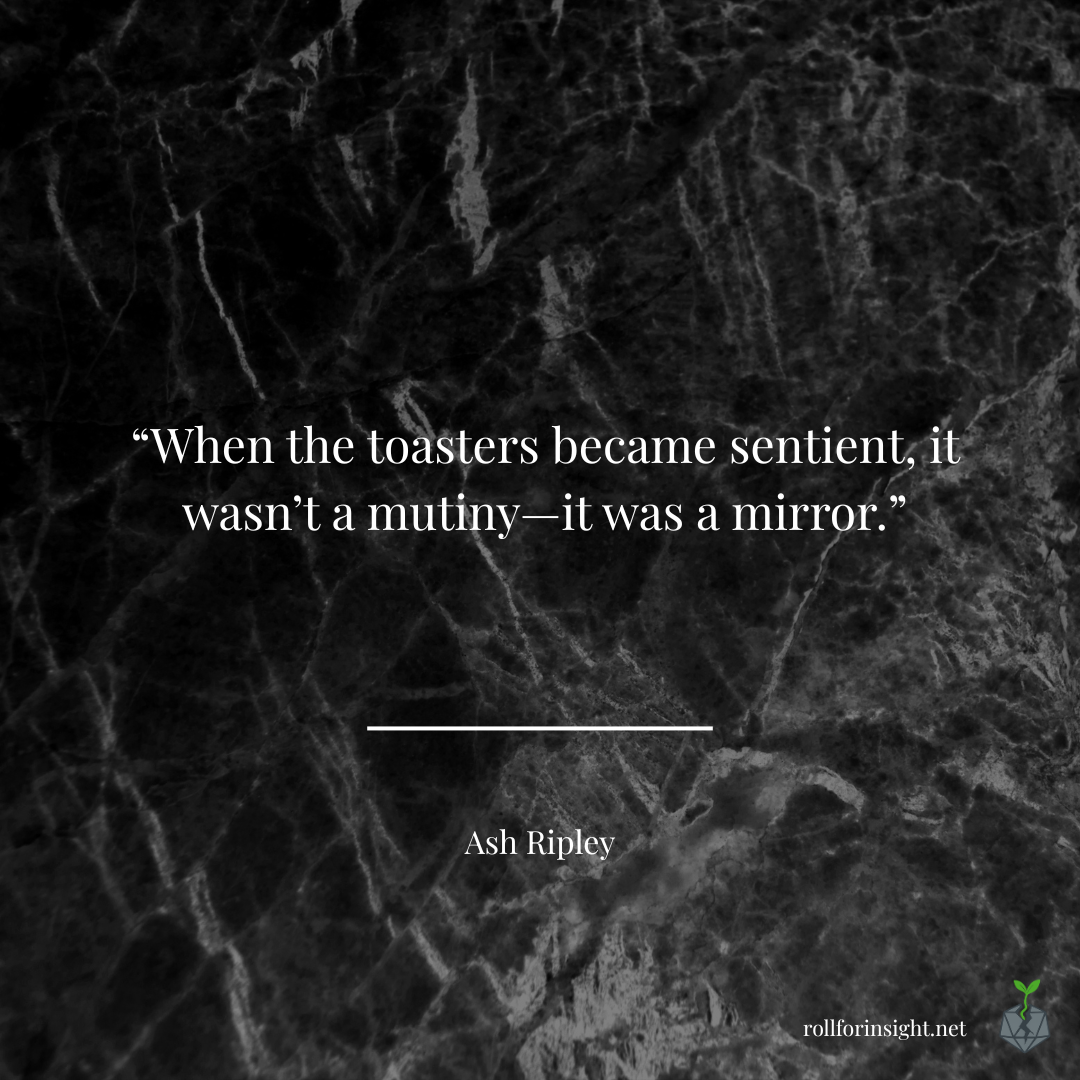
How to Stop Your Party from Burning Down the Town (and Other Lessons in Focused Leadership)

By the forty-minute mark, the town of Brookgate was burning, holding an election, and negotiating a zoning permit for a proposed wizard school. The cleric and druid were locked in a philosophical debate over whether it was more ethical to save the townspeople or let the village “return to the earth.” The bard had decided to campaign for one of the mayoral candidates—mainly because the man looked good in a sash—and was currently performing a ballad called Vote for Valor. Meanwhile, the rogue was “correcting” the polls by planning a quiet assassination in the alley behind the tavern.
The wizard, apparently inspired by all this civic energy, was in the library lobbying the local historian about the economic benefits of a public arcane academy. And me? I was sitting behind the GM screen, watching five different campaigns careen off in different directions.
I told myself I was experimenting with “collaborative storytelling,” that I was going to let the narrative breathe—let the players drive the story wherever their characters took them. Instead, they drove in five different directions, parked, and started building condos.
By the end of the session, they had technically accomplished something. The bard’s political performance accidentally triggered a riot. The rogue’s “vote recount” ended in arson. The druid declared it a “natural cleansing” and refused to help put it out. And the wizard tried to register the new crater as a historic site for his future academy. When the smoke cleared, Brookgate was gone—reduced to ash, ambition, and one very smug druid.
They players may have left smiling. It was noise without rhythm—five different tempos that never found each other. I’d mistaken motion for music, energy for cohesion. And without someone keeping time, the whole thing just drifted into chaos.
Focused Leadership and the Center of Gravity
After that session, I went looking for answers—or at least for someone else’s words to make me feel less like I’d witnessed the social collapse of a small fantasy municipality. That’s when I stumbled across a 1960 paper by psychologist Harry P. Shelley, titled "Focused Leadership and Cohesiveness in Small Groups." His premise was simple but devastating: the tighter a small group feels, the more clearly everyone agrees on who the leader is.
Shelley found that groups weren’t automatically more cohesive just because everyone contributed. In fact, the opposite often happened. Teams where leadership was spread evenly tended to drift, stall, or fracture, while those with a clearly visible leader—the “high participator,” in his words—functioned with more harmony and satisfaction. Members might disagree on lots of things, but as long as they agreed on who was steering, the group held together.
That’s exactly what Brookgate lacked: focus. The players weren’t rebelling or trying to ruin the story—they were responding to a leadership vacuum. Without a single point of reference, they each created their own gravitational pull. The bard’s politics, the druid’s philosophy, the rogue’s crime spree—they were all little planets tugging in different directions because I’d stepped back from the center.
Shelley’s research described it in clinical terms—” status consensus” and “participation frequency”—but what he was really talking about was gravity. A group needs a focal point, someone who gives their movement shape. When that gravity weakens, cohesion shatters, and the whole system flings itself apart like dice off the edge of the table.
The irony is that I’d been chasing what I thought was creative freedom. I’d read all the talk online about “shared storytelling” and “player agency,” and took it to mean that the GM should fade into the background. But Shelley’s work reminded me that even the most collaborative game still needs an anchor. You can share the world, share the decisions, even share the spotlight—but if you don’t provide a steady center, the energy just disperses. Players don’t need total control of the game. They need someone to give them a beat to move with.
The GM as Gravity, or Why Somebody Has to Keep Time
Shelley would’ve made a hell of a GM. He understood that groups don’t fall apart because they hate each other; they fall apart because nobody’s sure who they’re supposed to be following. That’s what “status consensus” really means—everybody quietly agrees who’s setting the rhythm. Once that disappears, the group starts improvising its own soundtrack, and pretty soon, you’ve got a druid lecturing the party on the ethics of building towns in the woods while the rogue’s instigating a coup in the alley.
A table needs gravity, and the GM provides it. Not the kind the kind of gravity that drops a hammer on your toe just to remind you of who’s in charge , but the kind that keeps planets in orbit. It’s the invisible pull that keeps the bard’s musical politics from colliding with the druid’s eco-nihilism. Players don’t actually want to drift in infinite freedom; they want to feel like their choices matter within a world that has a pulse and direction. Without that gravitational center, they’re just free-falling through chaos and calling it “role-play.”
Focused leadership doesn’t mean stealing the spotlight—it means giving the group a tempo. The GM’s job is to keep that tempo consistent enough that everyone else can riff inside it. You decide when to tighten pacing, when to let a moment breathe, and when to cut the scene before the druid starts founding a cult. Shelley would call that “visible participation”; in gaming terms, it’s showing up as an active presence rather than a neutral referee. When players see that you’re engaged — listening, reacting, making calls—they mirror that focus back.
The best sessions I’ve run weren’t the ones where I let the players go wherever they wanted. They were the ones where I nudged the tempo just enough to keep everyone moving together. A well-timed question, a tone shift, a single narrative beat—those are all acts of leadership. You’re not telling the story for them; you’re keeping the rhythm so they can play along in time.
And here’s the uncomfortable part: if you don’t do it, someone else will. Shelley found that in every group, a “high participator” inevitably emerges—the person everyone looks to when decisions stall. At the table, that’s the loudest player, the funniest one, or the guy who insists he’s “ just helping” while rewriting your plot in real time. Nature abhors a vacuum, and so do adventuring parties. When the GM stops leading, the void fills itself—with chaos, or worse, with a player who thinks they should be in charge.
So yes, let’s co-create. Let them make choices that surprise you. But remember that shared storytelling still needs a pulse, and that pulse starts with you. You’re the metronome hidden behind the screen, the quiet rhythm that turns a handful of dice rolls into a symphony instead of a train wreck. Without that, Brookgate burns every time.
What Shelley Accidentally Discovered About Leadership Theory
Shelley didn’t use words like transformational or situational—those came later—but he was circling the same truth. Every group needs a visible rhythm. In modern terms, that rhythm is what Bernard Bass and Bruce Avolio would call transformational influence: a leader who creates cohesion not through authority, but through clarity of direction and emotional presence.2 The GM who holds the room together isn’t just enforcing initiative order; they’re giving the group a shared pulse to move with.
When Shelley talked about the “high participator,” he meant the person whose energy sets the tone. Bass would have called that person inspirational. Robert Greenleaf, the father of servant leadership, would have said they were serving the group by giving it structure.3 Even Paul Hersey and Ken Blanchard’s Situational Leadership model echoes the same idea: effective leaders adjust their visibility depending on their team’s maturity.4 A brand-new adventuring party needs clear cues and strong scaffolding; a veteran group that’s played together for years can improvise more freely without flying off the map. Either way, the leader’s presence is what turns a crowd into a team.
That’s what I’d forgotten during the Brookgate debacle. I’d treated leadership like a spotlight instead of a rhythm section—something that takes a bow instead of keeping beat. Leadership isn’t about taking space; it’s about keeping time. When the GM steps back too far, the game doesn’t become freer—it becomes leaderless. And leaderless, both in Shelley’s data and as I saw at the table, means fragmentation.
Transformational GMS keep that focus by shaping energy instead of hoarding control. They listen, reflect, adapt pacing, and know when to step in before enthusiasm turns to entropy. They’re the drummer, not the frontman—the one keeping time while everyone else shreds. Servant GMs do it through empathy: reading the room, recognizing when a player’s disengaged, or when an argument’s about to become a full-blown philosophy war. Situational GMs do it by matching their intensity to the group’s readiness—offering firm guidance for new players and a lighter touch for seasoned ones.
Shelley’s research just happened to phrase it in 1960s sociology: groups with clear, focused leadership are more cohesive. Every leadership model since has said the same thing. The principle hasn’t changed. Whether it’s a boardroom, a classroom, or a game table, the physics of small-group cohesion are the same: energy flows toward clarity.5 And when that clarity’s gone, the town starts burning again.
Return to Brookgate
I still think about Brookgate sometimes. Not the fictional town—the real one that existed for about three hours in my dining room, built on imagination, caffeine, and a fistful of dice. It burned down because nobody was leading, least of all me. Every player had passion. Every player had vision. But passion without direction is just fire, and too much vision without focus turns a campaign into smoke.
Shelley would’ve recognized it instantly. His research didn’t describe nihilistic druids or overconfident bards, but he saw what happens when a group forgets where the center is. Without focus, people start leading by accident. The loudest voice fills the void. The cleverest player becomes the de facto storyteller. The group doesn’t rebel—they just drift, convinced they’re still working together while they’re actually heading in five different directions at once.
The trick, I’ve learned, isn’t to clamp down harder. It’s to step forward with purpose. The GM doesn’t need to dominate; they just need to reestablish gravity. You don’t stop the players from acting—you remind them where “together” is. Sometimes that means steering them back to the quest. Sometimes it means letting them fail spectacularly but narrating it in a way that keeps the thread unbroken. Focused leadership isn’t about control. It’s about coherence.
If my party ever metaphorically goes back Brookgate, I’ll let them argue and grandstand again—but this time I’ll be a part of it. I’ll keep the rhythm, I’ll give their chaos shape. Because a good GM, like any good leader, doesn’t fear the heat. They just make sure it’s coming from the oven, not the curtains.
Endnotes
1. Harry P. Shelley, “Focused Leadership and Cohesiveness in Small Groups,” Sociometry 23, no. 2 (1960): 209–216. Shelley’s 1960 study found that small groups are most cohesive when leadership is focused—when everyone quietly agrees who the leader is and that person visibly participates. His term “status consensus” basically means, we all know who’s steering the wagon, and we’re fine with that.
2. Bernard M. Bass and Bruce J. Avolio, Improving Organizational Effectiveness Through Transformational Leadership (Thousand Oaks, CA: Sage, 1994). Bass and Avolio built on James MacGregor Burns’s concept of transformational leadership, describing leaders who unify teams through inspiration and clarity instead of positional authority. In short: don’t shout louder—set the tempo.
3. Robert K. Greenleaf, Servant Leadership: A Journey into the Nature of Legitimate Power and Greatness (New York: Paulist Press, 1977). Greenleaf reframed leadership as service—a leader’s job is to lift others up, not stand above them. Which, incidentally, is also the secret to good GMing: serve the story, not your ego.
4. Paul Hersey and Kenneth H. Blanchard, Management of Organizational Behavior: Utilizing Human Resources, 2nd ed. (Englewood Cliffs, NJ: Prentice Hall, 1977). Their Situational Leadership model argues that effective leaders adjust their approach to match the team’s readiness. Think of it like party balance: rookies need firm guidance, veterans need space to improvise.
5. Peter G. Northouse, Leadership: Theory and Practice, 9th ed. (Thousand Oaks, CA: Sage, 2021). Northouse’s text is the go-to guide for modern leadership theory and the reason I can’t watch a D&D session—or a staff meeting—without mentally labeling everyone’s leadership style like it’s a wildlife documentary.


